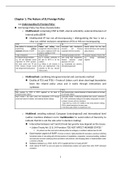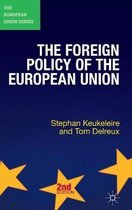Chapter 1: The Nature of EU Foreign Policy
1.1 Understanding EU Foreign Policy
EU Foreign Policy has three characteristics
o Multifaceted: comprising CFSP & CSDP, eternal action(EA), external dimension of
internal policy(EDIP)
Multifaceted FP but not all-encompassing = distinguishing the four is not a
clear cut, neither exclusive competence of EU or MS nor encompassing
CFSP CSDP EA EDIP
Main platform for developing and Civilian and military crisis Encompass trade, development, Internal policies that also have
implementing political, management instrument which can economic and financial external dimensions with important
diplomatic dimension of EUFP be used to implement EUFP and cooperation with third countries policy relevance
reinforce credibility of CFSP
Treaty of Maastricht Treaty of Lisbon Developed gradually since EEC European Integration Process ‘90s
EU interests through mediation Due to voluntary contribution of have strong legal competences, e.g. energy, environment,
e.g. HR and diplomatic service MS opts for NATO or ad hoc financial resources, proper migration
responsible for CFSP operation, coalitions apparatus in the area
MS retain control over FP and e.g. Military & civil missions in e.g. humanitarian aid, sanctions,
CFSP missions through Council Africa and neighbourhood. Fully international agreement
and intergovernmental dynamics controlled by MS esp. intrusive
military actions.
o Multimethod: combining intergovernmental and community method
Duality of TEU and TFEU = Treaty of Lisbon; can’t draw clear legal boundaries
btwn the related policy areas and it works through interactions and
symbiosis
TEU TFEU
Main provision for CFSP & CSDP organized on the basis of Main external action, external dimension of internal policies on the basis
intergovernmental method of community method
Intgv’t method = MS retain control over development of FP through Community method = institutional equilibrium btwn council, commission,
council and council of ministers, and unanimity decision makings EP, CJEU, and decision makings on the majority voting system in council
a. Balance of power within EU institutions
- Supra level e.g. Comm, EP: inability to veto during decision makings,
CJEU’s judicial oversight on the issue areas
b. MS shall accept transfer of competences to EU
o Multilevel: entailing national, European Union(regional) and international level
(author mentions Wallace’s term ‘multilocation’ to avoid notion of hierarchy to
indicate that EU is not the sole actor in decision making)
Interaction between nat’l and EU level but gravity may depend on the issues.
= Lisbon Treaty Art 13 & 14 Provision “DO NOT AFFECT MEMBER STATES “
EU policies are often mirrored at national politics but ambiguity in multilevel relations btwn EU-MS
Governance aspect of EUFP (Tommel & Verdun): highly diversified EU procedure, practices combining
formalized modes of rule-setting with informal practices of negotiations, cooperation, consensus-building, multilevel
and multi-actor structure underlying these procedures and practices, and diverging patters of implementation under
a common umbrella
Multilateral institutions e.g. OSCE, NATO, WTO in parallel with them of nearly all EUFP
Avoid national FP-EUFP as zero-sum game but complementary positive sum game that’s when EUFP witnessed
evolutions
1
, ο Bottom line is EUFP is structuring behavior and mindset of other actors in
international politics
1.2 Areas of Tension in EUFP
Tension areas have impact on both macro-picture of treaty changes and EUFP evolution
but also micro-picture responses to specific FP dossiers. Concerning sovereignty,
integration, power and interest’s issues
Not a clear cut tensions esp. in intgvt-comm method
· CFSP is developed with relevance to other comm method FP (e.g. trade, association agreement) thus,
other community method applicable in grey area btwn CFSP’s intgvt method and comm method.
· Besides, Council was forced to rely on other EU policy domains to implement CFSP and Commission
developed its unspoken FP domain through external policies since Lisbon Treaty’s EEAS. (HR/VP of
Commission only partially overcome divide btwn two approaches)
EU Integration Civilian power vs. military power Intergovernmental External objective
vs. Atlantic Solidarity vs. Community method vs. Internal objectives
FR centred EU’s effort to Civilian power(Duchene): power Intgvt (MS dominant): MS retain EO aim at influencing external
develop its own defence to transform interstate relations control over decision making environment that has IO but not
system(EDC, Fouchet plan) vs. within Europe from war to through European Council, made explicit
NATO centred defence civilized politics without military Council and through dominance
instruments of unanimity (CFSP CSDP
method)
Eastern enlargement: Central & Afghan, Iraq, Libya turmoil Comm (supra+bop in supra lv.) : IO categories
Eastern European MS consider awakened limited military MS should accept power a) inter-relational objectives to
NATO as vital for security capacity problem transfer to EU supra level in EP manage mutual trust
guarantee concerning RS thus, and Commission, inability to b) integrational objectives to
Atlantic factor remains powerful veto in decision making and affect European integration
judicial oversight of CJEU(EDIP c) assert EU identity
& EA)
1.3 Back to treaties: principles and objectives
TEU Art 21(1) = core objective and principles of EU international actions which it
seeks to advance these areas in the wider world
EU NPE(Normative Power Europe): EU has power to shape conception of norms in
international relations with values as constitutive features of EU and EUFP
ο Democracy
ο Rule of law
ο Universality & indivisibility of HR & fundamental freedom
ο Respect for human dignity
ο Principles of equality & solidarity
ο Respect for principles of UN charter and Intl law
TEU Art 21(2) writes core goals of components
ο CFSP/CSDP = preserve peace, prevent, conflict, and strengthen international security
ο Development policy = foster Sustainable development of developing countries with primary
goal of eradicating poverty
ο Trade policy = encourage integration of all countries into world economies
Drawbacks
ο Provisions are too general to which MS could easily subscribe but leave scope for different
views to approach the goals (e.g. eradicating poverty through development aid or trade?)
2
, ο No priority in principles? All principles are equally important to EU?: In reality, while trade policy
has diverse exclusive tool box, security capacity is limited in competences and instrument
ο Objective may not always be compatible in practice: in reality, RS and CH related are often not
consistent as it has a dilemma of sanctions as it might impede cooperation to tackle those issue
areas with them those, ‘consistency’ in external actions in different policy areas barely
attainable
1.4 Relational to Structural FP
ο FP’s fundamental goal is about influencing structure that determines how other
actors behave(structural), not just shaping or managing relations with other
actors(relational)
= Goal 1 is to shape and influence structure, Goal 2 is to produce sustainable
efforts in creating an enduring structure
= SFP is beyond national capacity but EU has material support(association and
cooperation agreement, financial instruments, technical and legal expertise) as
well as immaterial factors(to which structures are seen as legitimate and part of
belief system, culture or identity of people concerned)
ο How RFP and SFP differ?
RFP SFP
FP that seeks to influence attitude or behaviour of Long-term. Aimed at sustainably influencing or shaping
other actors, relations with and between other structures and seeks to promote structural changes
actors(usually devoted to crises and conflicts) and reforms(more diverse issue areas of structure)
ο Structural power(Holsti): capacity to shape organizing principles and rules of the
game and determine how other actors will play the game
e.g. US after WWII: Western Europe’s new structure to resolve FR-GR tensions,
or EU at Western Balkan 2000 and Central & Eastern Balkans in 90s to support structural
transformation in these regions
Strength of SFP: more changes to internalize when structural changes are perceived
as desirable and legitimate, not just as the result of external pressure or a purely
relational cost-benefit calculations(Wendt)
- Internalized process = facilitate when structures and structural changes to some
degree account for indigenous contents, process, preferences, sensitivities in
the target country or society (Tilly & Goodin, Migdal)
(Box 1.1) Importance of societal level in SFP context: These societal level can be
more important than state or inter-state level in terms of identity, legitimacy, and
effectiveness
- Societal level = diverse ways in which groups of people are persistently
connected on the basis of ethnicity or religion(Waever) or kinship(extended
family or clan in Western Balkans) or large religion groups(Shitte-Sunnis)
- Societal security = ability of a society to persist its essential character (thus,
sustainability is important as it allows acceptance of diverse culture and
languages)
- Lack of societal security e.g. Western European model rejection in Southern
Mediterranean and Islamism
1.5 Globalizing Context of FP
3
, Linking globalization to FP leads to duality
- While globalization reflects higher dominance of economic policy over foreign
policy, the implication of globalization and vulnerability makes FP more
essential which is why EU acts to protect itself from globalization and acts as an
agent of globalization (e.g. neo liberal international order)
1.6 Conclusion = conceptual backbones of the book
Relational vs. Structural FP: Complementary effect, rather than contradictory
Three characteristics: multifaceted(includes CFSP, CSDP, EA, EDIP),
multimethod(combines intgvt and comm method), and multilevel(embedded in
int’l context and comprise national policies of MS)
Areas of tensions: Eur Integration vs. Atlantic Solidarity, Civilian vs. Military power,
intergovt vs. community, external vs. internal objectives
4





